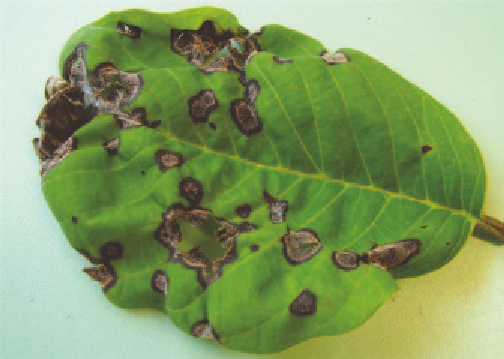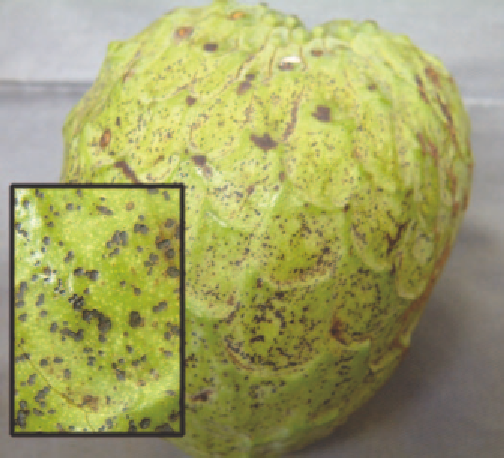Agriculture Reference
In-Depth Information
Prune foliage to ensure the skirt is 500 mm above the
ground. This will minimise humidity in the canopy
and ensure optimum spray coverage.
•
Calibrate air blast and other sprayers to ensure good
coverage.
•
Adopt a recommended spray program that rotates
fungicides.
•
BLACK CANKER
■
Cause
The fungus
Phomopsis annonacearum
.
Symptoms
On fruit, purple spots occur, ranging in size from small
specks to blotches covering half the fruit. Cracks may form
in the affected areas.
Tissues under the spots are brown and rotted to a depth
of generally no more than 10 mm. Symptoms closely
resemble, and may be easily confused with, damage caused
by fruit-spotting bug. The fungus also causes scorching
of leaf margins.
Fig 8.4 Anthracnose on custard apple leaf.
Source of infection and spread
The fungus survives and produces spores on infected leaves
and mummified fruit on and under trees. These are spread
by wind and rain. Humid conditions favour disease
development.
Importance
The disease is generally of minor importance and specific
control measures are not required.
Fig 8.5 Anthracnose pepper spot showing pinhead-size spots on the
fruit surface. Inset: close up of pepper spot lesions.
Management
•
Remove and destroy dead branches and mummifi ed fruit
before fruit set.
Importance
Anthracnose was insignificant until the mid-2000s. There
were major losses in northern New South Wales in 2006.
The disease has the potential to become a major problem
if good tree hygiene is not practised.
Management
•
Manage trees to ensure that leaves, infected fruit and
prunings are removed from the tree or covered
with straw to break the disease cycle.
Spray dormant trees once or twice with copper
fungicide. Ensure that these are high-volume sprays.
Do not apply if buds have broken.
•
Fig 8.6 Black canker in custard apple showing external and internal
symptoms. Note that the rot does not penetrate very far into the fruit.















